
Antique orientalist paintings in the carpet market
Oriental rugs are the art of connoisseurs, like other antiquities. They have always been a symbol of fine art and the property of nobles and royalty. Over the centuries, it may seem that we have an abundance of beautiful rugs to admire, but in reality only a fraction of them are mentioned in historical records.
These creations transport us to the world of imagination, and despite the disappearance of a large part of this art, many orientalist painters believed that it was a suitable material for their drawings, and in the world of fine arts we have the best evidence of the form of these masterpieces, in this article we will shed light on the world of carpet market paintings Until we see the treasures it contains.
Persian and oriental carpets in paintings
Renaissance artists provided a rich source of information about the designs of ancient Persian and Ottoman carpets, but we got the richest information from later artists.
The late Middle Ages and the Renaissance were golden ages for the manufacture and design of carpets and rugs, and in that period many traditional designs and motifs appeared. However, during the eighteenth century, many carpet weaving centers were affected by the conditions of war and invasion, which gave them less time to innovate and produce new ones in Carpet World.
Interest in oriental rugs revived in the late 19th century, and many traditional weaving centers began producing and creating other new designs, which caught the attention of Orientalist painters, who often traveled to the Near East and recorded their observations in detail, designing strict procedures and standards for the accuracy of their drawings. This is considered one of the best historical records about carpets for the generations that came after them. The group of paintings (Carpet Market) is considered one of the most groups that depict carpets in paintings, which takes us on a journey to the world of luxurious carpets in the second golden age of carpet weaving and arts.

Market in Jaffa. An orientalist painting by Gustav Bauernfeind.
Paintings and carpet market artists
There is a long list of carpet market paintings and artists, and it will take a lot of effort when listing them all, so we collected a number of the most beautiful works, and the first orientalist on this trip is the artist Jean-Leon Jerome.
Carpet Bazaar from the 19th century by Jean-Léon Gerome
"The Carpet Merchant" is one of the most famous paintings of the (Carpet Market) group of Western Orientalists. It was painted by Jean-Léon Gerome in 1887. This painting shows a small group of curly carpets placed on the floor, but the central point of the painting is the wonderful carpet hanging on the balcony, and the amazing details appear The carpet is from the painting, and a smaller carpet can also be seen hanging behind it. The painting also shows a group of wealthy buyers wishing to buy carpets, while an entourage of bodyguards stands in the background. The most amazing aspect of this work is that it gives us a clear view of the size and details of this work. amazing.
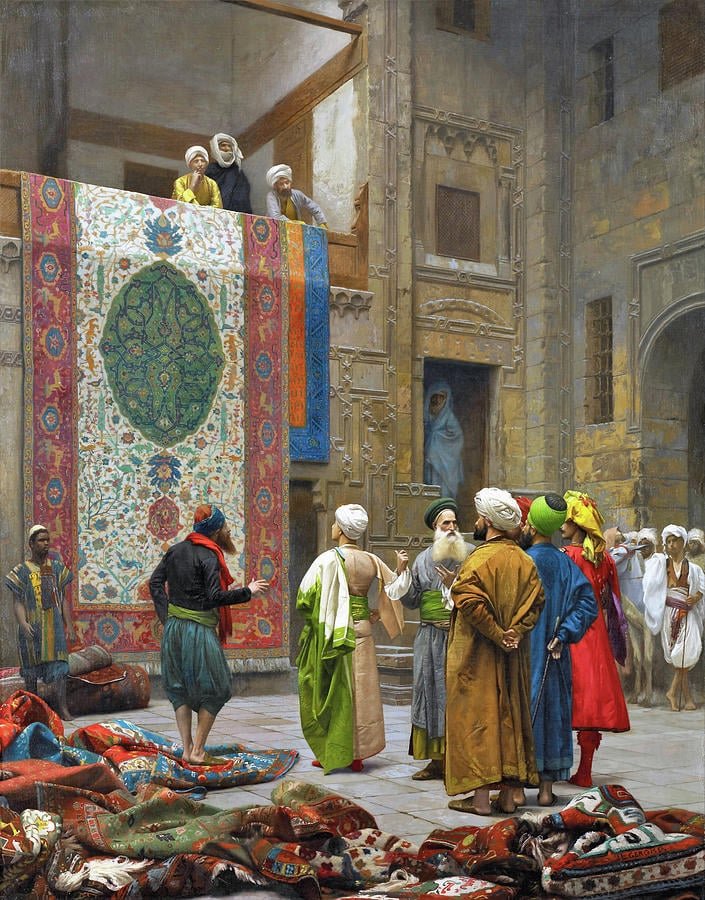
carpet dealer. by Jean Leon Gerome.
Orientalist and market carpet painter Charles Robertson
The painter and orientalist Charles Robertson was fascinated by carpet and rug dealers, and many of his paintings embodied the Cairo markets. One of his best works is The Cairo Carpet Seller, which he painted in 1887. This wonderful piece shows many fine examples of carpets, and draws attention to a masterpiece. Integrated design.
As we can see in this painting, the artist shows the cloth curtain in a way that translates into a very accurate drawing of the fabric, and gives us an idea of its size in proportion to human figures. The thing worth noting is that the wonderful green and bright purple color of the carpet on the right side in the painting is considered one of the rare colors ( to this day), and requires high skills to obtain it from natural plant dyes.
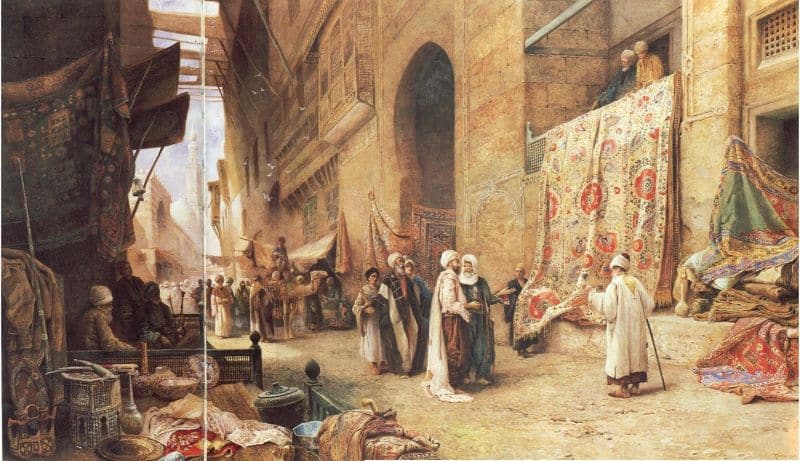
Carpet seller in Cairo. by Charles Robertson.
“Cairo” is another painting by Charles Robertson, showing a merchant carrying a typical example of a village carpet as it appears.
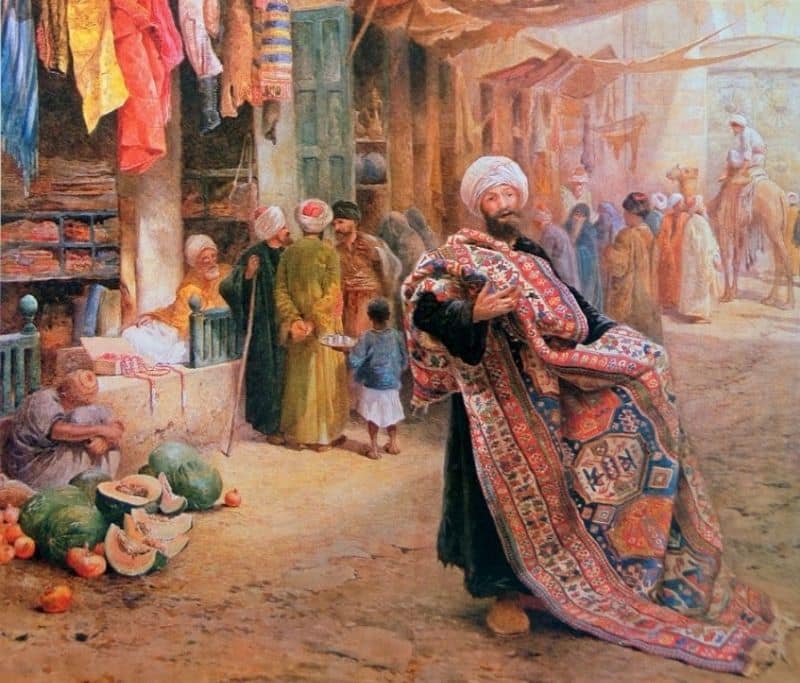
Cairo carpet seller. by Charles Robertson.
Charles Robertson's painting, "The Cairo Carpet Seller" 1887, is considered like the stock of carpets of the late nineteenth century, in this painting we can observe examples of carpets from many parts of the world, including a distinctive Kazak carpet hanging on the left side of the painting, and we can see A large Ottoman rug on the right side hangs in the corridor, as we see what appear to be many examples of tribal and village rugs in the painting. This painting shows the global reach and importance of the art of carpet making at the end of the nineteenth century.
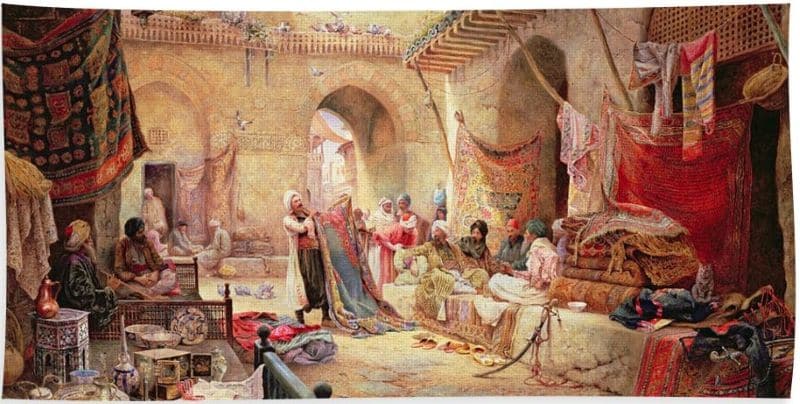
The Carpet Market, by Charles Robertson.
Through these valuable paintings, you can smell the aroma of coffee and spices as you wander around the oriental carpet market that these artists painted, and there are many wonderful artists and paintings that can be included in this list, as the carpet market paintings provided a glimpse into a world that few people have ever seen. For us, it gives us an appreciation of the fine examples still in our hands, places them in their rightful place as universal treasure and holds us responsible for their preservation.
Other oriental art collections and pieces from the carpet market
The paintings of Jean-Léon Jerome and Charles Robertson include some of the most famous works that give us a glimpse into the world of oriental rugs, but many other artists were inspired by this style of painting to follow in their path. Sotheby's auction house has one of the most extensive collections of orientalist paintings in the world.
The experience inspired Orientalists to look beyond the boundaries of their own experiences to explore what lies beyond the confines of their own world. Ludwig Deutsch is another painter known for his meticulous depictions of textiles, carpets, and building details. He worked on drawing early on for accuracy, rather than relying on his memory.
The painting "Morning Prayer" was painted in Paris in 1906, and it depicts a place in a mosque and a man appears in it performing the dawn prayer on the wonderful Anatolian carpet. Taller is distinguished by its bright colors, but it is not a “prayer” rug, and this confirms that any rug can be used as a prayer rug.

Morning prayer. Ludwig Deutsch.
Another painting by Ludwig Deutsch, "On Prayer". It shows an exquisite mosque carpet decorated with a medallion design, and you may notice that the colors and patterns of the carpet closely match the mosaics on the mosque wall.
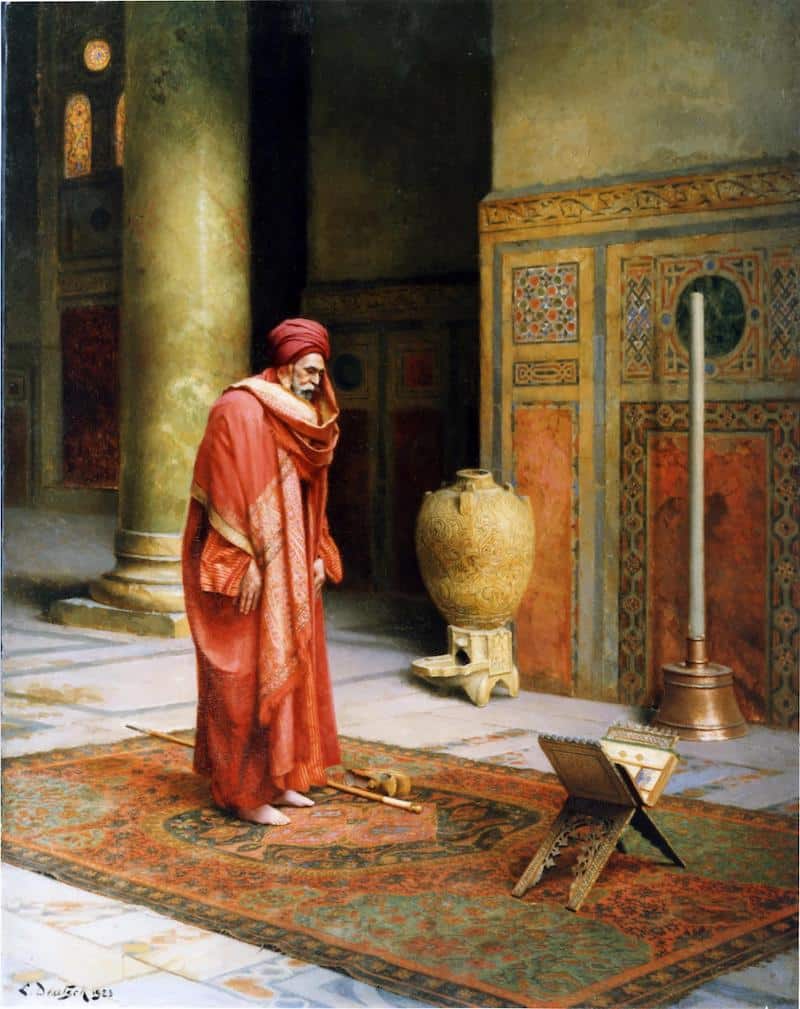
when praying. Ludwig Deutsch, 1923
The orientalist's trip "Frederick Arthur Bridgman" to Egypt inspired him to paint only one painting in 1879, but it was an important contribution to the history of carpets. , and are very similar to many of the rugs in existence today.
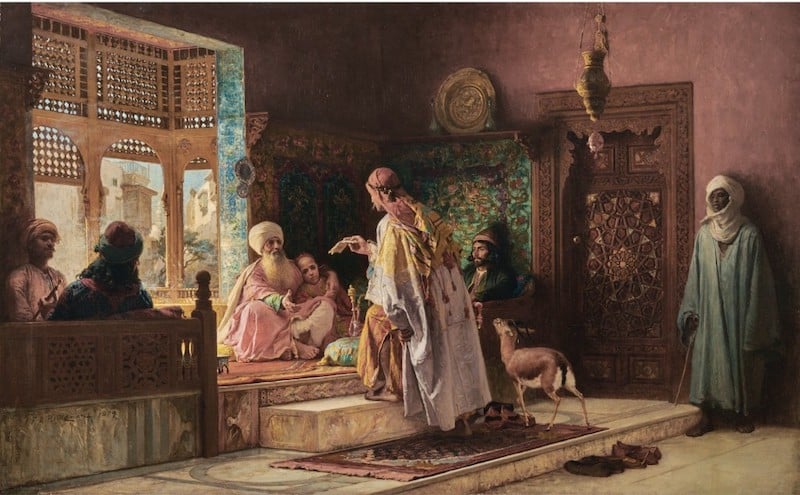
Prophet. by Frederick Arthur Bridgman 1879
In his painting Learning the Qur'an, Frederick Bridgman shows the utilitarian nature of rugs and their importance in daily use. It is evident that this rug is coarsely woven and without a formal design, which means that its primary purpose is to cover floors only.

Learn the Quran. by Frederick Bridgman.
Rudolf Ernst depicts in his painting "Rüstem Pasha Mosque, Constantinople" many rugs used in daily life in that period, where the scholar sits on carpets of small size and bright colors, and on the wall hung larger Persian carpets, and throughout the floor, can be seen Layers of carpets of larger and smaller sizes with brown weave, simple lines and consistent patterns, and we can know directly that these pieces are utilitarian pieces for the purpose of covering floors only, while there are other carpets stacked throughout the panel, and this panel indicates that there are different categories of carpets for use for purposes different.

Rustem Pasha Mosque, Constantinople. by Rudolf Ernst.
Playing the Drum, by Charles James Theriot in 1889, shows a longer pile rug with simple geometric designs, probably created for simple utilitarian purposes and for everyday use. The rug is softer and warmer than shown in the painting.
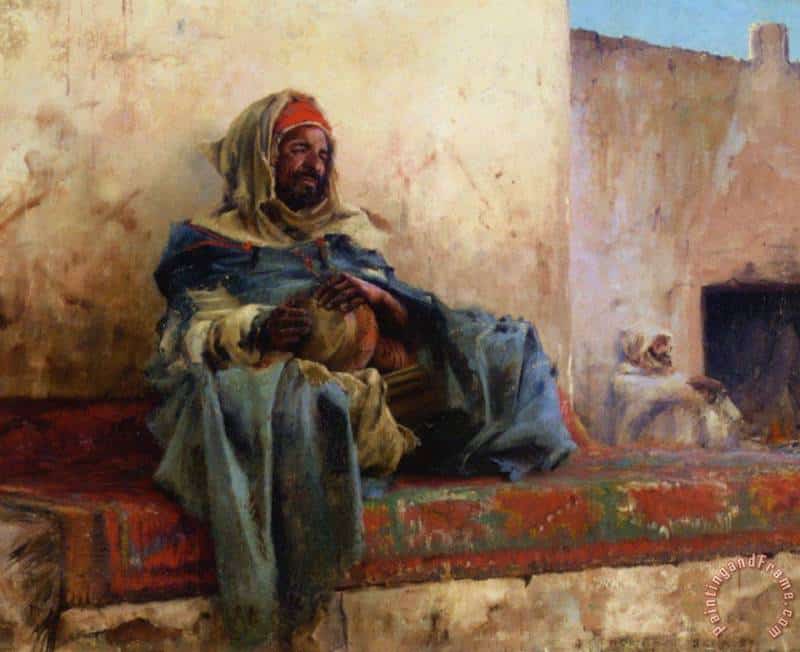
playing the drum. Charles James Theriot 1889
Rudolf Ernst's other painting, "Young Ladies on the Balcony", shows a maid resting on a balcony overlooking a lake, and it shows several layers of carpets and several different levels of art. In the painting, a brown carpet similar to those depicted in earlier paintings appears, which is This means that these served as a base or underlayment for the beautifully patterned carpets of the period.

Young Ladies on the Balcony, by Rudolf Ernst.
These paintings shed light on the importance of carpets in the late nineteenth and early twentieth centuries. This group depicts simple examples and carpets designed for use for a specific purpose, and the other to evoke heritage and spirituality. These rugs depicted in artistic paintings are a small part of those carpets that have been woven and still exist to this day.
What works of art have you come across before that depict the world of ancient carpets?
Translated by: nazmiyalantiquerugs.com
Share

































